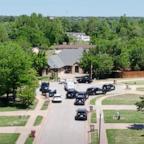Work Anywhere: Boeing to Offer In-Flight Wi-Fi
— -- Boeing this week joined the ranks of companies offering planes equipped with Wi-Fi service with the introduction of its new high-speed Internet service, Connexion by Boeing.
I tested it during a special flight on a Boeing 737-400. At 15,000 feet in the air, chatting with my husband on AOL Instant Messenger was just like doing it from my desk.
Wi-Fi service is already available on about 70 planes operated by ANA, China Airlines, Japan Airlines, Lufthansa, SAS, and Singapore Airlines, though not on domestic U.S. flights, a fact that many experts attribute to finances. "You haven't seen much in major capital investments since 9/11," says Jack Evans, spokesperson for the Air Transport Association. "Some airlines are still dealing with the bare essentials of survival."
Boeing uses a two-way satellite link to communicate with a network of ground-based stations. To use the service, you must create a profile for the access point in your computer's wireless configuration client, and then visit the Connexion Web site to sign in. Connexion costs $30 on most international routes, $20 for flights of less than 6 hours, or $10 for 60 minutes of access, with each minute thereafter costing 25 cents.
Although some other people onboard had no problem logging on to the service, the wireless card in my laptop refused to redirect to the Connexion IP address. Rebooting my wireless didn't work--it took one of Boeing's tech experts and some command-line magic to address the issue. Another passenger had difficulties connecting due to interference with his VPN client.
That's a main problem with in-air broadband: Random glitches can occur, and an SAS flight isn't going to have experts who can help you troubleshoot. Boeing spokespeople say that flight attendants may be able to reach tech support through VoIP phones or text chat on their own Internet-connected machines--but such systems aren't standard.
Once set up, you can expect DSL-like speeds, says Tim Vinopal, director of service delivery engineering. Maximum throughput to the plane is 20 megabits per second, which Vinopal says translates to a passenger average of 150 to 200 kilobits per second. On our test flight, speeds felt pokier than DSL but not painful. E-mail and instant messaging worked fine, and you could even log in to corporate networks via VPN.
While Boeing's Connexion is the most complete service to date, other companies are also in the game. Switzerland-based OnAir--a joint venture including Boeing rival Airbus--is using satellite to offer a more-limited selection of services, including in-seat Short Message Service (SMS) and proxy access to Web-based e-mail and instant messaging. OnAir plans to add a live IP service by 2007 that will give passengers full Web browsing and VPN capabilities.
Meanwhile, companies like Verizon Airfone, makers of seatback phones, are working on a terrestrial solution that links a plane's access point to ground stations. The air-to-ground connection would use the 4-MHz spectrum that air phones currently use. According to Verizon Airfone president Bill Pallone, the FCC will be auctioning off that spectrum by March 2006, after which companies can deploy their Wi-Fi systems. Pallone hopes to see this technology in the air by March 2007.
Unlike satellite technology, though, air-to-ground isn't suitable for overseas travel. Since ground towers have a radius of about 150 to 200 miles, the technology wouldn't work, for example, over the Atlantic. Pallone says the technology is intended for flights that operate within North America.
So is this what consumers want?
According to a December report published by market research firm In-Stat, 44 percent of those surveyed said that they would be interested in Wi-Fi on airplanes. "People are willing to pay something, but they're not willing to pay a lot," says Allen Nogee, principal analyst at In-Stat. However, he points out, business users can usually expense the charge.
Business traveler Jen Martin would like to see more Wi-Fi on planes. "A 9-plus-hour flight means I'm usually a day behind on e-mail already. The ability to conduct business during a long-haul flight seems like a no-brainer."
Not everyone is excited about the prospect, though. As business traveler Chris Charla puts it, "If you give me Wi-Fi, I will have to work. The airplane is the last place I can actually read a book during the day without guilt."




